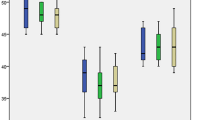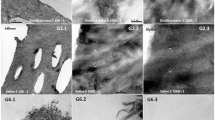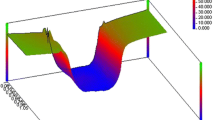Abstract
Objectives
The aim of this study was to investigate the capability of a novel reference point indentation apparatus to test the indentation properties of root canal surface dentine treated with three intracanal medicaments used in endodontic regeneration.
Materials and methods
Immature human premolars were selected (n = 22). Four specimens were obtained from each root and randomly assigned to three treatment groups and a control group. Each specimen was exposed to one of the three treatment pastes (triple antibiotic (TAP), double antibiotic (DAP), or calcium hydroxide (Ca(OH)2)) or neutral deionized water (control) for 1 or 4 weeks. After each time interval, the indentation properties of the root canal dentine surfaces were measured using a BioDent reference point indenter. Two-way ANOVA and Fisher's protected least significant differences were used for statistical analyses.
Results
Significant differences in indentation parameters and estimated hardness between all groups at both time points were found. TAP-treated dentine had the highest significant indentation parameters, followed by DAP-treated dentine, untreated control dentine, and Ca(OH)2-treated dentine, respectively. Furthermore, TAP-treated dentine had the lowest significant estimated hardness, followed by DAP-treated dentine, untreated control dentine, and Ca(OH)2-treated dentine, respectively.
Conclusion
BioDent reference point indenter was able to detect significant differences in indentation properties of root canal dentine treated with various medicaments.
Clinical relevance
The use of a reference point indenter is a promising approach to characterize the indentation properties of root canal surfaces without any surface modification. This might provide an in vitro mechanical measurement that is more representative of the actual clinical situation.


Similar content being viewed by others
References
Diogenes A, Henry MA, Teixeira FB, Hargreaves KM (2013) An update on clinical regenerative endodontics. Endod Top 28:2–23
Thibodeau B, Trope M (2007) Pulp revascularization of a necrotic infected immature permanent tooth: case report and review of the literature. Pediatr Dent 29:47–50
Lenzi R, Trope M (2012) Revitalization procedures in two traumatized incisors with different biological outcomes. J Endod 38:411–414
Ding RY, Cheung GS, Chen J, Yin XZ, Wang QQ, Zhang CF (2009) Pulp revascularization of immature teeth with apical periodontitis: a clinical study. J Endod 35:745–749
Lovelace TW, Henry MA, Hargreaves KM, Diogenes A (2011) Evaluation of the delivery of mesenchymal stem cells into the root canal space of necrotic immature teeth after clinical regenerative endodontic procedure. J Endod 37:133–138
Miller EK, Lee JY, Tawil PZ, Teixeira FB, Vann WF Jr (2012) Emerging therapies for the management of traumatized immature permanent incisors. Pediatr Dent 34:66–69
Trope M (2010) Treatment of the immature tooth with a non-vital pulp and apical periodontitis. Dent Clin North Am 54:313–324
Chen MY, Chen KL, Chen CA, Tayebaty F, Rosenberg PA, Lin LM (2012) Responses of immature permanent teeth with infected necrotic pulp tissue and apical periodontitis/abscess to revascularization procedures. Int Endod J 45:294–305
De-Deus G, Paciornik S, Mauricio MH (2006) Evaluation of the effect of EDTA, EDTAC and citric acid on the microhardness of root dentine. Int Endod J 39:401–407
White JD, Lacefield WR, Chavers LS, Eleazer PD (2002) The effect of three commonly used endodontic materials on the strength and hardness of root dentin. J Endod 28:828–830
Yoldas O, Dogan C, Seydaoglu G (2004) The effect of two different calcium hydroxide combinations on root dentine microhardness. Int Endod J 37:828–831
Randall C, Mathews P, Yurtsev E, Sahar N, Kohn D, Hansma P (2009) The bone diagnostic instrument III: testing mouse femora. Rev Sci Instrum 80:065108
Diez-Perez A, Guerri R, Nogues X, Caceres E, Pena MJ, Mellibovsky L, Randall C, Bridges D, Weaver JC, Proctor A, Brimer D, Koester KJ, Ritchie RO, Hansma PK (2010) Microindentation for in vivo measurement of bone tissue mechanical properties in humans. J Bone Miner Res 25:1877–1885
Rasoulian R, Raeisi Najafi A, Chittenden M, Jasiuk I (2013) Reference point indentation study of age-related changes in porcine femoral cortical bone. J Biomech 46:1689–1696
Gallant MA, Brown DM, Organ JM, Allen MR, Burr DB (2013) Reference-point indentation correlates with bone toughness assessed using whole-bone traditional mechanical testing. Bone 53:301–305
Guerri-Fernandez RC, Nogues X, Quesada Gomez JM, Torres Del Pliego E, Puig L, Garcia-Giralt N, Yoskovitz G, Mellibovsky L, Hansma PK, Diez-Perez A (2013) Microindentation for in vivo measurement of bone tissue material properties in atypical femoral fracture patients and controls. J Bone Miner Res 28:162–168
Nosrat A, Homayounfar N, Oloomi K (2012) Drawbacks and unfavorable outcomes of regenerative endodontic treatments of necrotic immature teeth: a literature review and report of a case. J Endod 38:1428–1434
Aref M, Gallant MA, Organ JM, Wallace JM, Newman CL, Burr DB, Brown DM, Allen MR (2013) In vivo reference point indentation reveals positive effects of raloxifene on mechanical properties following 6 months of treatment in skeletally mature beagle dogs. Bone 56(2):449–453
Hansma P, Turner P, Drake B, Yurtsev E, Proctor A, Mathews P, Lulejian J, Randall C, Adams J, Jungmann R, Garza-de-Leon F, Fantner G, Mkrtchyan H, Pontin M, Weaver A, Brown MB, Sahar N, Rossello R, Kohn D (2008) The bone diagnostic instrument II: indentation distance increase. Rev Sci Instrum 79:064303
Pashley D, Okabe A, Parham P (1985) The relationship between dentin microhardness and tubule density. Endod Dent Traumatol 1:176–179
Kinney JH, Balooch M, Marshall SJ, Marshall GW Jr, Weihs TP (1996) Hardness and Young's modulus of human peritubular and intertubular dentine. Arch Oral Biol 41:9–13
Inoue T, Saito M, Yamamoto M, Debari K, Kou K, Nishimura F, Miyazaki T (2009) Comparison of nanohardness between coronal and radicular intertubular dentin. Dent Mater J 28:295–300
Twati WA, Wood DJ, Liskiewicz TW, Willmott NS, Duggal MS (2009) An evaluation of the effect of non-setting calcium hydroxide on human dentine: a pilot study. Eur Arch Paediatr Dent 10:104–109
Kinney JH, Marshall SJ, Marshall GW (2003) The mechanical properties of human dentin: a critical review and re-evaluation of the dental literature. Crit Rev Oral Biol Med 14:13–29
Yassen GH, Chu TM, Eckert G, Platt JA (2013) Effect of medicaments used in endodontic regeneration technique on the chemical structure of human immature radicular dentin: an in vitro study. J Endod 39:269–273
Yassen GH, Vail MM, Chu TG, Platt JA (2013) The effect of medicaments used in endodontic regeneration on root fracture and microhardness of radicular dentine. Int Endod J 46:688–695
Sahebi S, Moazami F, Abbott P (2010) The effects of short-term calcium hydroxide application on the strength of dentine. Dent Traumatol 26:43–46
Maruyama H, Aoki A, Sasaki KM, Takasaki AA, Iwasaki K, Ichinose S, Oda S, Ishikawa I, Izumi Y (2008) The effect of chemical and/or mechanical conditioning on the Er:YAG laser-treated root cementum: analysis of surface morphology and periodontal ligament fibroblast attachment. Lasers Surg Med 40:211–222
Minabe M, Takeuchi K, Kumada H, Umemoto T (1994) The effect of root conditioning with minocycline HCl in removing endotoxin from the roots of periodontally-involved teeth. J Periodontol 65:387–392
Tomson PL, Grover LM, Lumley PJ, Sloan AJ, Smith AJ, Cooper PR (2007) Dissolution of bio-active dentine matrix components by mineral trioxide aggregate. J Dent 35:636–642
Conflict of interest
The authors declare that they have no conflict of interest.
Author information
Authors and Affiliations
Corresponding author
Rights and permissions
About this article
Cite this article
Yassen, G.H., Chu, TM.G., Gallant, M.A. et al. A novel approach to evaluate the effect of medicaments used in endodontic regeneration on root canal surface indentation. Clin Oral Invest 18, 1569–1575 (2014). https://doi.org/10.1007/s00784-013-1125-x
Received:
Accepted:
Published:
Issue Date:
DOI: https://doi.org/10.1007/s00784-013-1125-x




